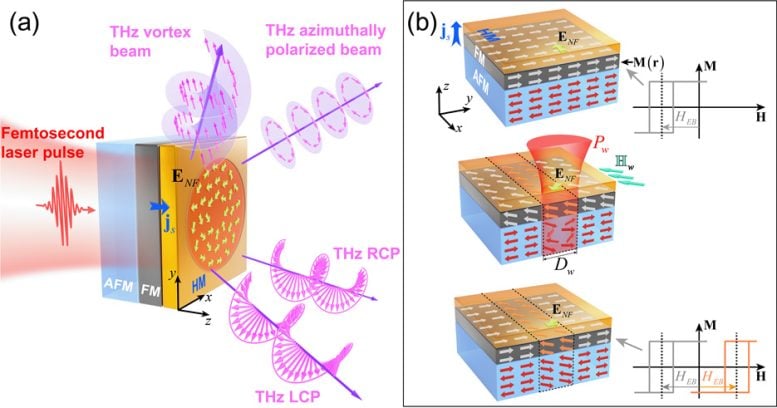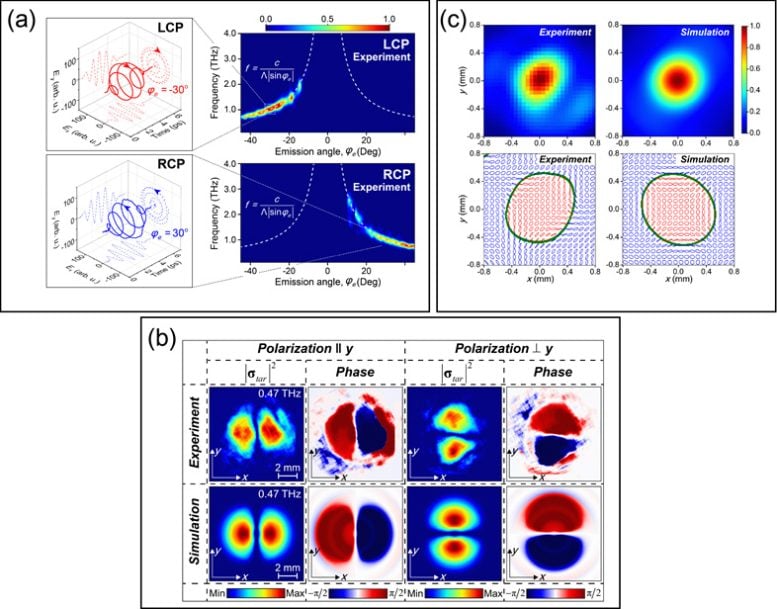
Researchers have created a new method to generate structured terahertz light beams using programmable spintronic emitters, marking a significant advancement in terahertz technology. This innovation allows for the generation and precise manipulation of light with both spin and orbital angular momentum. The technology has potential applications in security, medical imaging, and communication. This development overcomes previous challenges in generating and controlling terahertz light, paving the way for novel devices with enhanced capabilities. Credit: SciTechDaily.com
Researchers have developed a new method to generate and manipulate structured
This new research, led by Prof. Zhensheng Tao, Prof. Yizheng Wu from Fudan University, and Prof. Yan Zhang from Capital Normal University, overcomes these limitations by employing programmable spintronic emitters based on exchange-biased magnetic multilayers. These devices consist of thin layers of magnetic and non-magnetic materials that convert laser-induced spin-polarized currents into broadband terahertz radiation.

(a) Schematic diagram of the experimental setup. (b) Schematics of the laser-assisted-magnetic-programming method. Credit: Shunjia Wang, Wentao Qin, Tongyang Guan, Jingyu Liu, Qingnan Cai, Sheng Zhang, Lei Zhou, Yan Zhang, Yizheng Wu, Zhensheng Tao
Innovations in Light Polarization
“The key innovation lies in our ability to flexibly program the magnetization pattern within the emitter with high precision and high spatial resolution,” graduate student and first author Shunjia Wang explains. “This allows us to design and generate terahertz beams with complex polarization states, including beams with spatially separated circular polarizations, azimuthal or radial polarization states, and even a full Poincaré beam.”
A Poincaré beam exhibits all possible states of light polarization within its cross-section. This unique property has applications in areas like generating special optical forces, achieving flat-top intensity profiles, and single-shot polarimetry measurements.

(a) Programmed terahertz emitter for spatially separated left- and right-circularly polarized terahertz radiation. (b) Programmed terahertz emitter for azimuthal polarization. (c) Programmed terahertz emitter for the full Poincaré beam. Credit: Shunjia Wang, Wentao Qin, Tongyang Guan, Jingyu Liu, Qingnan Cai, Sheng Zhang, Lei Zhou, Yan Zhang, Yizheng Wu, Zhensheng Tao
The researchers successfully demonstrated the generation of various structured terahertz beams using their programmable emitters. These beams hold promise for advancing terahertz technologies in numerous fields.
“Our findings pave the way for the development of novel terahertz devices with enhanced functionalities,” concludes Prof. Zhensheng Tao. “The ability to manipulate terahertz light with such precision opens exciting possibilities for applications in spectroscopy, sensing, and communication.”
Reference: “Flexible generation of structured terahertz fields via programmable exchange-biased spintronic emitters” by Shunjia Wang, Wentao Qin, Tongyang Guan, Jingyu Liu, Qingnan Cai, Sheng Zhang, Lei Zhou, Yan Zhang, Yizheng Wu and Zhensheng Tao, 8 July 2024, eLight.DOI: 10.1186/s43593-024-00069-3
The study was funded by the National Key Research and Development Program of China, the National Natural Science Foundation of China, the Shanghai Municipal Science and Technology Basic Research Project, and the National Key Research Program of China.